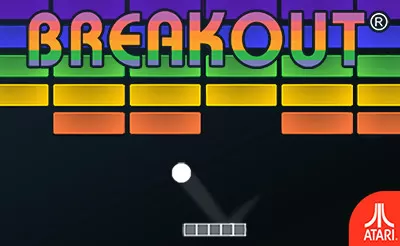

Atari Breakout
Atari Breakout, released in 1976, is a classic arcade game that embodies simple yet addictive gameplay. Designed by Nolan Bushnell and Steve Bristow, with significant contributions from a young Steve Wozniak, the game presented a revolutionary concept: players controlled a paddle at the bottom of the screen and used it to bounce a ball upwards, aiming to destroy a wall of bricks at the top. Each brick eliminated earned the player points, and the objective was to clear the entire wall as quickly as possible. The game's mechanics were straightforward to learn but challenging to master. Players needed to precisely control the paddle to direct the ball, anticipate its trajectory, and react quickly to keep it in play. The ball's speed increased with each successive brick broken, adding to the increasing difficulty. This escalating challenge kept players engaged and motivated to improve their skills. Breakout's success stemmed from its intuitive design and satisfying feedback loop. The satisfying 'thwack' of the ball hitting a brick, the visual reward of bricks disappearing, and the increasing pace of the game all contributed to a compelling and enjoyable experience. It quickly became a popular fixture in arcades, captivating players with its blend of skill, strategy, and simple entertainment. Beyond its immediate popularity, Atari Breakout had a lasting impact on the video game industry. It helped establish the single-player arcade game as a viable form of entertainment and influenced the design of countless games that followed. Its simple yet engaging gameplay continues to resonate with players today, cementing its status as a true classic.
Play GamesOverview
- Technology:HTML5
- Platform:Browser (desktop, mobile, tablet)
Recommended for you

Secrets of Charmland
Rate:5.0
● Unique gameplay: help Emma treat her friends by swapping and matching delicious sweets! ● Tons of match-3 levels filled with exciting elements, awesome boosters and explosive combinations! ● A world full of Charmland: discover all the magical places it has to offer! ● Fantastic characters: watch Emma making new acquaintances and helping them with their unusual quests.

Laddu Champion
Rate:3.0
Food is swinging gently from a rope. To score a slam dunk, time the Laddu's release to make it fall nicely into the basket. How many perfect catches can you make? Features: - A fun theme, perfect for outdoor - Unlimited levels for unlimited gameplay - Bonus points for factors such as speed, ricochets, and accuracy - Beautiful street scene - A variety of obstacles such as bouncers and spikes, to make things challenging - Stuck? Earn coins to purchase magnets and springs to help

Stickman vs Zombies
Rate:4.0
Ninja vs Zombies is an action-packed platformer. Fight your way through challenging environments filled with zombie hordes and dangerous traps deadly not just for ninja, but zombies too (giant saw blades, fire, acid, explosive barrels, spikes, spears, rolling stones...). Use throwing ninja knives and sword combo attacks to defeat zombies. Be fast or else zombies will get you!

Tap Cricket
Rate:4.5
Tap Cricket is a mobile game that captures the exhilarating essence of cricket in a simple, yet addictive format. Forget complex controls and lengthy tutorials; this game focuses on the pure joy of hitting boundaries and taking wickets, all with a tap of your finger. It's the perfect game for cricket enthusiasts looking for a quick fix of batting and bowling action, as well as casual gamers seeking a fun and engaging mobile experience. The core gameplay is incredibly intuitive. As a batsman, you'll time your taps to smash the incoming deliveries all around the ground. The better your timing, the more likely you are to score runs, clear the boundary, and send the crowd into a frenzy. As a bowler, you'll strategically choose your delivery type and aim to outsmart the batsman, taking crucial wickets to restrict the opponent's score. Tap Cricket isn't just about simple controls, however. Strategic decision-making plays a significant role in your success. You'll need to assess the field placements, analyze the bowler's patterns, and adapt your batting style accordingly. On the bowling side, varying your pace and spin can be the key to deceiving even the most experienced virtual batsmen. With a vibrant and colorful art style, coupled with responsive and fluid animations, Tap Cricket delivers a visually appealing experience. The game features a variety of teams and tournaments to unlock, keeping the gameplay fresh and providing ongoing challenges. Whether you're aiming for the highest score in a quick match or competing for championship glory, Tap Cricket offers a satisfying and accessible cricket experience for players of all skill levels.

Noob: Zombie Prison Escape
Rate:3.0
Noob: Zombie Prison Escape is an action platforming game inspired by the style of Minecraft. Your mission is to help Noob escape from a zombie-infested prison by finding keys, coins, solving puzzles, avoiding traps, and using parkour skills to navigate platforms. Along the way, you'll need to shoot down monsters with a crossbow, complete tasks involving torches, and face various challenges in 10 different levels and 6 challenges.

Idle Inventor
Rate:4.5
Grow your industrial powerhouse: become a heavy machine titan of industry! Manufacture cars, trucks, planes, military vehicles, and high-tech instruments for space exploration! Watch your factory grow from a single production line to a world-famous industrial powerhouse. And because you're automating, your factory keeps working while you're away - check in the morning, it's amazing to see how much money you made while sleeping Try it now, and see how the idle tycoon life suits you!
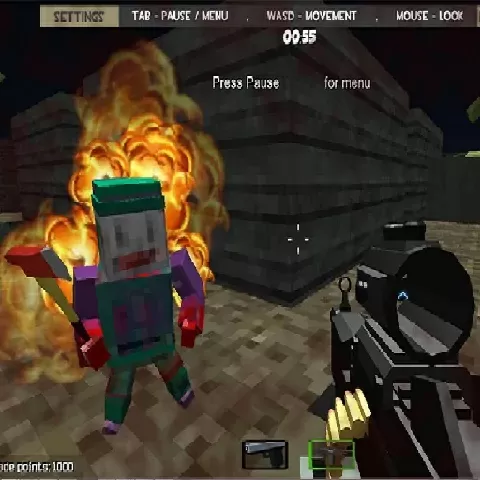
Pixel gun apocalypse
Rate:3.5
The long awaited th edition of the Pixel Gun Apocalypse series has finally arrived Just like in the previous editions Pixel Gun Apocalypse is a multiplayer first person shooter with Minecraftstyle combat Get ready to fight against soldiers or zombies

Train Bandit
Rate:5.0
Become a fearless outlaw in the wild west. Engage in heart-pounding shootouts with sheriffs, amass stolen treasures, evade bullets with precision, and master the art of jumping from wagon to wagon with strategic prowess.

Winter Jewels Saga
Rate:5.0
Winter Jewel Saga is a match-3 game with 80 fun yet challenging levels online for free. Swap and match jewels in this jewel puzzle adventure to progress to the next level. Solve puzzles with quick thinking and smart moves. Plan your moves by matching 3 or more jewels in a row or col. Match four or more jewels to create power-ups.

Polygon Village
Rate:3.5
Create your own D world in Polygon Village The different building has different abilities such as houses create population and goods and so on Read the tips to know them well Have a good time in this creative game

Love and Treasure Quest
Rate:5.0
If you are looking for some fun and addictive type of game like PULL THE PIN & Grandscapes, then Love and Treasure Quest is one of the best choice for you. Get ready for an adventure as a knight as he seek his way to obtain treasure and save the Princess that he love.Test your skills as you figure out puzzles. Find out how you can get the treasure and avoid it from melting. See how you can defeat the enemy as you try to achieve your mission. Figure out which arrows needs to be removed and what sequence. Be careful with the spikes, boulder and poison gas. These obstacles can kill Monster, Hero or Princess.Have fun with more than 100 levels with unlimited lives. Try to earn as many coins as you can so that you can build our own castle.This game will surely test your problem-solving skills, pattern recognition and other cognitive skills. But most importantly, this game will surely give you lots of fun excitement. With its perfect match of music, effects and design, this game is

Idle Oasis
Rate:3.0
Idle Oasis presents a relaxing yet strategic gaming experience where players cultivate their own thriving ecosystem within a compact nine-tile grid. Each tile represents a plot of soil, dynamically displaying real-time temperature and humidity levels. Players begin by selecting seeds and carefully planting them in these plots, mindful of the environmental conditions each plant type prefers. A key aspect of the game lies in resource management and strategic purchasing. The in-game store offers a variety of tools designed to optimize plant growth. These tools range from simple watering cans that increase soil moisture to sophisticated drying machines that precisely control humidity levels. However, access to advanced tools is gated behind a reputation system, encouraging players to consistently produce high-quality plants. As your oasis flourishes, so does your ability to acquire better equipment. The core gameplay loop revolves around nurturing plants to full maturity. The higher the maturity level of a plant when harvested, the greater the monetary reward. Furthermore, fully matured plants offer the additional benefit of increasing the player's reputation, unlocking access to more advanced tools and features within the store. However, careful attention must be paid to plant health. Neglecting optimal conditions can lead to a decline in plant quality, which in turn diminishes the selling price. Even worse, a drop in plant quality also results in a reduced reputation reward upon harvest. Therefore, diligent monitoring of temperature and humidity, coupled with the strategic use of purchased tools, is crucial for maximizing profits and building a thriving, reputable oasis.

Magical Christmas Match 3
Rate:3.0
Magical Christmas Match 3 – this is a three in a row game, in which you have to put the blocks of the same christmas items in a series of three pieces or more to achieve the highest possible score, be careful to account the scale to the left did not fall too low, otherwise the game will be over. The game is done in a christmas style! Enjoy the game!

Mahjong Relax
Rate:4.5
Mahjong game with summer tiles and boards makes you feel an uninterrupted bliss of calm and relaxing beach atmosphere!! Time flies by, stress goes down, while your memory and mahjong skills are boosting...

Squid Assassin
Rate:4.5
Create an assassination plan against the workers and the killer doll and destroy them in Squid Assassin! Plan your destination and develop your strategy before committing the assassination. You must stay away from the gun of the killer baby and worker characters and make a silent slaughter whenever possible. You can choose the game character with different features from the Store menu and you can become even stronger. Start the Assassination without interruption with +50 different levels!

Halloween Bingo
Rate:3.0
So here comes the halloween season and what would be a better occasion to play game "bingo" in halloween style So bingo is a fun game we added the spinning wheel to it Spin the wheel, mark your numbers and compete with computer! Its a halloween fever lets start spinning!

Golf
Rate:3.5
Golf or a 2D Golf is a fun and challenging game, the aim of this game is to shot the ball into a finish hole, you can only shot no more than 5 times! Use your shooting skills to launch the golf ball and let it reach the hole. Don't let it go elsewhere, your aim is to put it inside the hole. It's all.
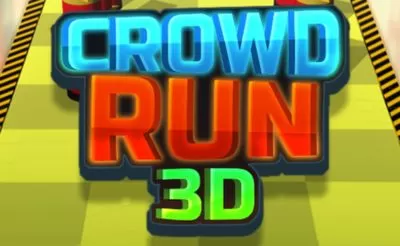
Crowd Run 3D
Rate:3.5
Crowd Run 3D offers a thrilling and addictive gaming experience where players navigate a dynamic urban landscape with the goal of building the largest possible crowd. As you sprint through the vibrant city streets, you'll encounter a variety of opportunities to gather followers and strategically expand your group. The core gameplay revolves around collecting individual runners scattered throughout the environment. Skillful navigation is essential to avoid obstacles, gaps, and enemy groups that can diminish your numbers. The bigger your crowd, the more powerful you become, allowing you to overcome larger obstacles and overwhelm smaller opposing groups. Success in Crowd Run 3D is not just about speed and agility, but also strategic decision-making. You'll need to carefully assess the environment, anticipate potential threats, and choose the most efficient routes to maximize your crowd's growth. Power-ups strategically placed along the course offer temporary advantages, such as increased speed or the ability to attract more followers. Mastering the use of these power-ups can significantly impact your progress and propel you ahead of your competitors. The game features progressively challenging levels with varying layouts and obstacles, ensuring a consistently engaging experience. As you progress, you'll unlock new characters and cosmetic items to personalize your runner and stand out from the crowd. The vibrant graphics, intuitive controls, and fast-paced action create a captivating and immersive experience. Whether you're looking for a quick burst of entertainment or a more extended gaming session, Crowd Run 3D offers endless replayability and excitement. Compete against yourself to beat your high scores or challenge friends to see who can command the largest crowd in this exhilarating race to the finish line.

Maggie Bread Rush
Rate:3.5
Get ready folks, time is short and Maggie has bread to serve, management game featuring eight unique levels that require quick thinking which sharpens time management of players in real life too. The objective is to leave no customer unhappy by fulfilling customers with specific bread orders as soon as possible. As time passes by and order status remain incomplete, players loose experience points from each customer. These stages become harder and harder, only a few reach ultimate levels.

Classic Tic Tac Toe
Rate:4.0
You like games that you play on a paper ? Classic Tic Tac Toe is for you ! Now you can play Tic Tac Toe on your mobile device for free. Classic Tic Tac Toe is the best selling "Tic Tac Toe" of all-time. Classic Tic Tac Toe supports one player or two player. You can play against another human or against the computer.

Secrets of the Castle - Match 3
Rate:5.0
Solve all the secrets of the mysterious castle! Secrets of the Castle - play this challenging match 3 game for free! Collect three crystals in a line and complete the levels! In the game you will find many difficult levels, obstacles and worthy rewards, as well as endless lives! This match 3 game already has more than five thousand levels! Game Features: Over 5000 exciting logic levels! Various obstacles and bonuses! Mystical graphics and soundtrack! Play this match 3 game for free!

Indian Tractor Farm Simulator
Rate:3.5
Become a modern farmer in Indian Tractor Farm Simulator! Immerse yourself in a huge open world and harvest many types of crops, take care of your livestock - cows, sheep, and pigs - take part in forestry, and sell your products on a dynamic market to expand your farm!

Cooking Mania
Rate:3.0
Live out your dreams as a chef in your own restaurant. Choose from one of the five different restaurants with rising difficulty. Upgrade your equipment to manage the growing amount of customers that love your food.

Fun Birds Hidden Stars
Rate:3.5
Welcome to Fun Birds Hidden Stars, a captivating free online skill and hidden object game that will challenge your observation skills! In this delightful adventure, your mission is to discover the hidden stars cleverly concealed within beautifully illustrated images of birds. Each level presents you with a unique scene, and you'll need to find all 10 hidden stars before time runs out. With a total of 6 exciting levels to conquer, the pressure is on! You must act quickly, as the clock is ticking. Be mindful, though—clicking in the wrong spot too many times will cost you precious time, deducting an additional 5 seconds for each mistake. Are you ready to put your skills to the test? Dive into Fun Birds Hidden Stars, and enjoy the thrill of the hunt while having fun!

Backgammon Multiplayer
Rate:3.0
Backgammon Multiplayer is a HTML5 Board Game. Enjoy this stylish version of the classic Backgammon Game. 3 Game's Mode: - Multiplayer mode - Play against the pc - Challenge a friend playing on the same device

Game of Goose
Rate:4.5
Are you ready to play a game that you were playing when you were a child : the game of goose also know as Snake and Ladders ? You can play alone or up to 4 players on the same screen to maximize the fun !!!! Enjoy this reskin version of the original board game and play for hours with your friends or family.

Join Clash 3d
Rate:4.0
Join Clash 3d is an interesting arcade game. It mix avoid, shooting, gun, collect, and monster elements. This is a very funny game with an easy method. In the beginning, you have only one soldier, you have to blow the barrels and collect others. In the meantime, pay attention to avoid the obstacles, they will lose your soldier. In the end, there will have many monsters rush out of caves. To beat them, you must have enough soldiers. Do not forget to upgrade the soldier's power.

Timberman
Rate:3.5
Timberman is a deceptively simple yet relentlessly addictive arcade game that tests your reflexes and strategic thinking. The core gameplay revolves around chopping down an endlessly tall tree as a lumberjack, but there's a crucial catch: branches are falling on both sides, and you need to quickly move left or right to avoid being crushed. The game presents a constant, ever-increasing challenge as the timer ticks down, demanding split-second decisions and precise movements. The charm of Timberman lies in its minimalist aesthetic and intuitive controls. With just two buttons – one for moving left and one for moving right – players can immediately jump into the action. This simplicity makes it accessible to players of all ages and skill levels, while the escalating difficulty ensures a compelling experience for even the most seasoned gamers. The game's pixelated graphics evoke a nostalgic feel, reminiscent of classic arcade titles, further enhancing its appeal. What truly sets Timberman apart is its ability to create intense moments of pressure and satisfaction. Successfully navigating a particularly fast series of branch falls is incredibly rewarding, while a single mistake can lead to a frustratingly abrupt end. This cycle of triumph and failure keeps players hooked, constantly striving to beat their previous high score. The addition of various lumberjack characters with unique visual styles adds a layer of customization, encouraging players to keep playing and unlocking new characters to personalize their experience. Beyond the core gameplay, Timberman also offers social elements that enhance the experience. Leaderboards allow players to compete against friends and other players worldwide, adding a competitive edge to the game. This encourages players to hone their skills and strive for the top spot, further extending the game's replayability. Timberman is more than just a time-killing app; it's a test of skill, a source of frustration, and a surprisingly addictive arcade experience that can be enjoyed in short bursts or extended play sessions.

Angry Flappy
Rate:3.5
"Angry Flappy is a fast-paced twist on the classic game, where players not only navigate through obstacles but also shoot bullets to destroy enemies and barriers. Get ready for an action-packed flying adventure!"

Ludo Wizard
Rate:4.5
Have fun with friends by playing the game Ludo Wizard. The game has 3 modes: - Vs Bot: Playing against the computer (offline) - Online: Playing with randomly matched people - With friends (private): Playing with your friends. Simply share a private code and connect to each other. PLAY NOW!

Survival Wave Zombie Multiplayer
Rate:4.5
Survival Wave Zombie Multiplayer free to play against much enemy AI like soldier and realistic zombie, 5 game modes like gun game, survival, TDM, DM and much more, multiplayer play with friends and camo + attachments at each gun. Have fun here.

Gift Craft
Rate:4.0
A fun but challenging Christmas game where youll need to create a Christmas gift before you run out of space Theres four modes to choose from Beginner Advanced Timed and Steps mode Start with Beginner mode and move to the Advanced mode once you beat the Beginner level Choose the Timed option to see how high of a score you can get in minutes or the Steps option to see how high of a score you can get in turns


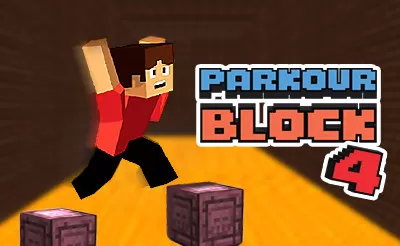

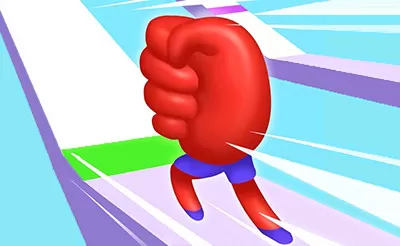






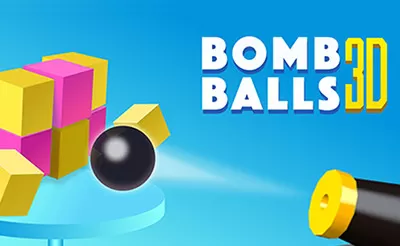



Discuss